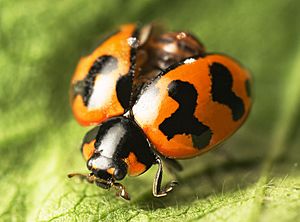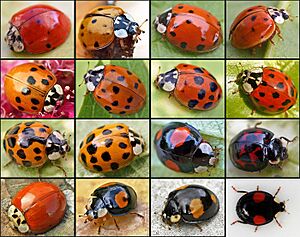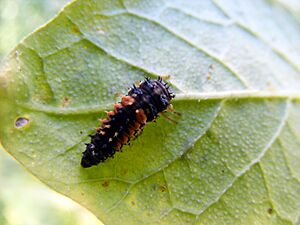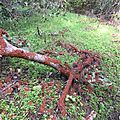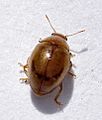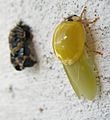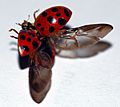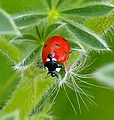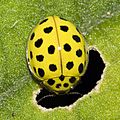Lady beetle facts for kids
Quick facts for kids Coccinellidae |
|
|---|---|
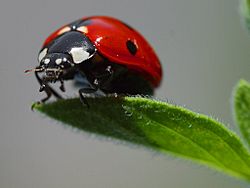 |
|
| Coccinella septempunctata (seven-spotted) | |
| Scientific classification | |
| Kingdom: | |
| Phylum: | |
| Class: | |
| Order: | |
| Suborder: | |
| Superfamily: |
Cucujoidea
|
| Family: |
Coccinellidae
|
Lady beetles, often called ladybugs or ladybirds, are a type of beetle. Scientists usually call them 'coccinellids' or 'lady beetles'. There are over 5,000 different kinds of lady beetles found all around the world.
Most lady beetles eat other insects. They especially like to eat small plant-eating insects called aphids (also known as greenfly) and scale insects. These insects can harm plants, so lady beetles are very helpful to farmers and gardeners. Even young lady beetles, called larvae, are very good at eating aphids.
One type of lady beetle, the Harmonia axyridis (or harlequin ladybug), was brought to North America from Asia in 1988. It was meant to help control aphids. Now, it is the most common lady beetle there. It has also spread to many parts of western Europe, reaching the UK in 2004.
Contents
Lady Beetle Defenses
Lady beetles often have bright colors like red, orange, or yellow with black spots. These bright colors are a warning sign to animals that might want to eat them. This warning system is called aposematism.
It works because predators, like birds, learn that brightly colored insects might taste bad or be poisonous. So, they learn to stay away from lady beetles.
If a predator tries to attack a lady beetle, the beetle can "reflex bleed." This means it pushes a bad-tasting liquid out of its leg joints. This liquid contains a toxin that makes predators quickly drop the lady beetle. Birds and other animals usually don't try to eat a lady beetle twice!
What Lady Beetles Look Like
Most people think of lady beetles as small, round, red beetles with black spots. In Europe, the most common one is the seven-spotted lady beetle, Coccinella septempunctata.
But not all lady beetles are red, and not all red ones have spots! Some are very tiny, black, and hairy. Lady beetles can be red, orange, pink, or yellow with black spots. Some are black with red spots, and others have no spots at all. A few even have shiny metallic blue colors, or patterns like checkerboards or stripes.
The front part of the lady beetle, which is usually black, is called the pronotum. This part covers its thorax and head.
Lady Beetle Life Cycle and Food
Most lady beetles spend the winter as adults. When spring comes, they become active again. Female lady beetles can lay many eggs, sometimes up to 1,000 in one summer! They often lay their eggs near groups of aphids, so the young larvae will have food when they hatch.
Lady beetle eggs hatch in about 3 to 4 days. The tiny larvae then grow through four stages, called instars, over 10 to 14 days. After this, they turn into a pupa. After a few more days, the adult lady beetle comes out of the pupa.
It only takes about four weeks for a lady beetle to change from a tiny egg to a full-grown adult. On average, a lady beetle lives for 1 to 2 years.
Almost all lady beetles are insectivores, meaning they eat other insects. They especially like soft-bodied insects like aphids. Since aphids are a big problem for farmers and gardeners, lady beetles are very helpful for controlling these pests. Some types of ants actually "farm" aphids and will try to protect them from lady beetles!
You can often find lady beetles on plant leaves in sunny areas. They help keep the balance of nature in gardens and forests by controlling insect pests.
There's even a research program called "The Lost Ladybug Project." It encourages families and children to go outside and look for lady beetles. This helps scientists track where different kinds of lady beetles are found.
Images for kids
-
Henosepilachna guttatopustulata, a plant-eating lady beetle, eating a potato leaf
-
A lady beetle Larva
-
The Pupal stage of a lady beetle
-
Pupal Stage
See also
 In Spanish: Mariquitas para niños
In Spanish: Mariquitas para niños


